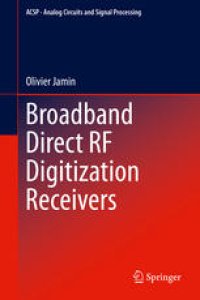
Ebook: Broadband Direct RF Digitization Receivers
Author: Olivier Jamin (auth.)
- Tags: Circuits and Systems, Signal Image and Speech Processing, Processor Architectures
- Series: Analog Circuits and Signal Processing 121
- Year: 2014
- Publisher: Springer International Publishing
- Edition: 1
- Language: English
- pdf
This book discusses the trade-offs involved in designing direct RF digitization receivers for the radio frequency and digital signal processing domains. A system-level framework is developed, quantifying the relevant impairments of the signal processing chain, through a comprehensive system-level analysis. Special focus is given to noise analysis (thermal noise, quantization noise, saturation noise, signal-dependent noise), broadband non-linear distortion analysis, including the impact of the sampling strategy (low-pass, band-pass), analysis of time-interleaved ADC channel mismatches, sampling clock purity and digital channel selection. The system-level framework described is applied to the design of a cable multi-channel RF direct digitization receiver. An optimum RF signal conditioning, and some algorithms (automatic gain control loop, RF front-end amplitude equalization control loop) are used to relax the requirements of a 2.7GHz 11-bit ADC.
A two-chip implementation is presented, using BiCMOS and 65nm CMOS processes, together with the block and system-level measurement results. Readers will benefit from the techniques presented, which are highly competitive, both in terms of cost and RF performance, while drastically reducing power consumption.
This book discusses the trade-offs involved in designing direct RF digitization receivers for the radio frequency and digital signal processing domains. A system-level framework is developed, quantifying the relevant impairments of the signal processing chain, through a comprehensive system-level analysis. Special focus is given to noise analysis (thermal noise, quantization noise, saturation noise, signal-dependent noise), broadband non-linear distortion analysis, including the impact of the sampling strategy (low-pass, band-pass), analysis of time-interleaved ADC channel mismatches, sampling clock purity and digital channel selection. The system-level framework described is applied to the design of a cable multi-channel RF direct digitization receiver. An optimum RF signal conditioning, and some algorithms (automatic gain control loop, RF front-end amplitude equalization control loop) are used to relax the requirements of a 2.7GHz 11-bit ADC. A two-chip implementation is presented, using BiCMOS and 65nm CMOS processes, together with the block and system-level measurement results. Readers will benefit from the techniques presented, which are highly competitive, both in terms of cost and RF performance, while drastically reducing power consumption.
· Provides system-level analysis of direct RF sampling & digitization receivers, from the antenna to the digital channel selection;
· Includes analysis of broadband non-linearity, applicable for low-pass and band-pass sampling strategies;
- Describes system-level design of an application-optimized signal conditioner, including a single-inductance multi-slope programmable RF amplitude equalizer, together with its control algorithm and a mixed-signal AGC loop combining RMS and peak detection.
This book discusses the trade-offs involved in designing direct RF digitization receivers for the radio frequency and digital signal processing domains. A system-level framework is developed, quantifying the relevant impairments of the signal processing chain, through a comprehensive system-level analysis. Special focus is given to noise analysis (thermal noise, quantization noise, saturation noise, signal-dependent noise), broadband non-linear distortion analysis, including the impact of the sampling strategy (low-pass, band-pass), analysis of time-interleaved ADC channel mismatches, sampling clock purity and digital channel selection. The system-level framework described is applied to the design of a cable multi-channel RF direct digitization receiver. An optimum RF signal conditioning, and some algorithms (automatic gain control loop, RF front-end amplitude equalization control loop) are used to relax the requirements of a 2.7GHz 11-bit ADC. A two-chip implementation is presented, using BiCMOS and 65nm CMOS processes, together with the block and system-level measurement results. Readers will benefit from the techniques presented, which are highly competitive, both in terms of cost and RF performance, while drastically reducing power consumption.
· Provides system-level analysis of direct RF sampling & digitization receivers, from the antenna to the digital channel selection;
· Includes analysis of broadband non-linearity, applicable for low-pass and band-pass sampling strategies;
- Describes system-level design of an application-optimized signal conditioner, including a single-inductance multi-slope programmable RF amplitude equalizer, together with its control algorithm and a mixed-signal AGC loop combining RMS and peak detection.
Content:
Front Matter....Pages i-xvi
RF Receiver Architecture State of the Art....Pages 1-38
System-Level Design Framework for Direct RF Digitization Receivers....Pages 39-97
Application to the System Design of a Multichannel Cable Receiver....Pages 99-123
Realization and Measurements....Pages 125-149
Back Matter....Pages 151-162
This book discusses the trade-offs involved in designing direct RF digitization receivers for the radio frequency and digital signal processing domains. A system-level framework is developed, quantifying the relevant impairments of the signal processing chain, through a comprehensive system-level analysis. Special focus is given to noise analysis (thermal noise, quantization noise, saturation noise, signal-dependent noise), broadband non-linear distortion analysis, including the impact of the sampling strategy (low-pass, band-pass), analysis of time-interleaved ADC channel mismatches, sampling clock purity and digital channel selection. The system-level framework described is applied to the design of a cable multi-channel RF direct digitization receiver. An optimum RF signal conditioning, and some algorithms (automatic gain control loop, RF front-end amplitude equalization control loop) are used to relax the requirements of a 2.7GHz 11-bit ADC. A two-chip implementation is presented, using BiCMOS and 65nm CMOS processes, together with the block and system-level measurement results. Readers will benefit from the techniques presented, which are highly competitive, both in terms of cost and RF performance, while drastically reducing power consumption.
· Provides system-level analysis of direct RF sampling & digitization receivers, from the antenna to the digital channel selection;
· Includes analysis of broadband non-linearity, applicable for low-pass and band-pass sampling strategies;
- Describes system-level design of an application-optimized signal conditioner, including a single-inductance multi-slope programmable RF amplitude equalizer, together with its control algorithm and a mixed-signal AGC loop combining RMS and peak detection.
Content:
Front Matter....Pages i-xvi
RF Receiver Architecture State of the Art....Pages 1-38
System-Level Design Framework for Direct RF Digitization Receivers....Pages 39-97
Application to the System Design of a Multichannel Cable Receiver....Pages 99-123
Realization and Measurements....Pages 125-149
Back Matter....Pages 151-162